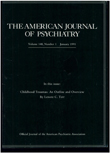Hierarchy of characteristics associated with depressive symptoms in an urban elderly sample
Abstract
In contrast to the uncertainty about the prevalence and importance of late-life depressive disorders, a consistent pattern of risk factors for depressive symptoms has been shown by studies using the Center for Epidemiologic Studies Depression Scale (CES-D). The authors surveyed a representative sample of 2,137 elderly community residents with the CES- D and found a hierarchy of characteristics associated with substantial levels of depressive symptoms: illness, disability, isolation, bereavement, and poverty. If these findings are confirmed by prospective studies, addressing modifiable factors in the emergence, persistence, and remission of depressive symptoms might extend the independent survival of older adults.
Access content
To read the fulltext, please use one of the options below to sign in or purchase access.- Personal login
- Institutional Login
- Sign in via OpenAthens
- Register for access
-
Please login/register if you wish to pair your device and check access availability.
Not a subscriber?
PsychiatryOnline subscription options offer access to the DSM-5 library, books, journals, CME, and patient resources. This all-in-one virtual library provides psychiatrists and mental health professionals with key resources for diagnosis, treatment, research, and professional development.
Need more help? PsychiatryOnline Customer Service may be reached by emailing [email protected] or by calling 800-368-5777 (in the U.S.) or 703-907-7322 (outside the U.S.).



